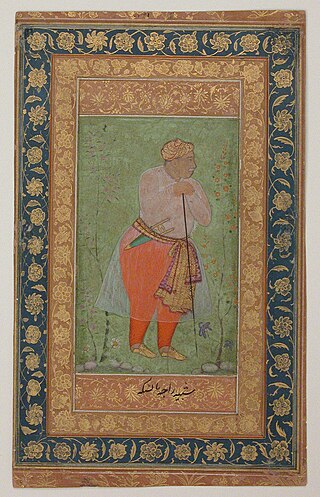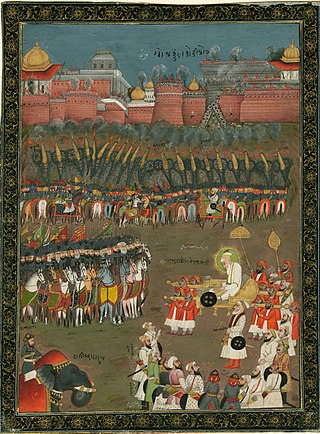
Murshidabad is a historical city in the Indian state of West Bengal. It is located on the eastern bank of the Bhagirathi River, a distributary of the Ganges. It forms part of the Murshidabad district.

Maharaja Suraj Mal, simply known as Suraj Mal, was a Jat ruler of Bharatpur State in the present-day state of Rajasthan. He is Known for his military prowess and administrative acumen, he established a prosperous kingdom in the region now encompassing parts of Rajasthan, Uttar Pradesh, and Haryana. Under him, Bharatpur State, a tributary of the House of Scindia, covered the present-day districts of Agra, Alwar, Aligarh, Bharatpur, Dholpur, Etawa, Hathras, Mainpuri, Meerut, Ghaziabad, Mathura, and Rohtak, Sonipat, Jhajjar, Nuh, Palwal, Faridabad, Kasganj, Mainpuri, Firozabad, Bulandshahr.

Mirza Azim-ush-Shan was the second son of the 8th Mughal Emperor Shah Alam I better known as Bahadur Shah I by his second wife a Rathore Rajput Princess Amrit Kanwarji of Kishangarh. He was the great grandson of Shah Jahan and the grandson of Aurangzeb during whose reign he was the imperial subahdar (governor) of Bengal Subah from the year 1697 to his death in 1712.

The Nawab of Bengal was the hereditary ruler of Bengal Subah in Mughal India. In the early 18th-century, the Nawab of Bengal was the de facto independent ruler of the three regions of Bengal, Bihar and Orissa which constitute the modern-day sovereign country of Bangladesh and the Indian states of West Bengal, Bihar and Odisha. The Bengal Subah reached its peak during the reign of Nawab Shuja-ud-Din Muhammad Khan. They are often referred to as the Nawab of Bengal, Bihar and Orissa. The Nawabs were based in Murshidabad which was centrally located within Bengal, Bihar, and Odisha. Their chief, a former prime minister, became the first Nawab. The Nawabs continued to issue coins in the name of the Mughal Emperor, but for all practical purposes, the Nawabs governed as independent monarchs. Bengal continued to contribute the largest share of funds to the imperial treasury in Delhi. The Nawabs, backed by bankers such as the Jagat Seth, became the financial backbone of the Mughal court.

RajaMan Singh I was the 24th Maharaja of Kingdom of Amber from 1589 to 1614. He also served as the Subahdar of Bihar from 1587 to 1594, then for Bengal for three terms from 1595 to 1606 and the Subahdar of Kabul from 1585 to 1586. He served in the Mughal Army under Emperor Akbar. Man Singh fought sixty-seven important battles in Kabul, Balkh, Bukhara, Bengal and Central and Southern India. He was well versed in the battle tactics of both the Rajputs as well as the Mughals. He is commonly considered to be one of the Navaratnas, or the nine (nava) gems (ratna) of the royal court of Akbar.

Bardhaman, or sometimes Burdwan and Barddhaman, is a former district in the Indian state of West Bengal, headquartered in Bardhaman. On 7 April 2017, the district was bifurcated into two separate districts namely Purba Bardhaman and Paschim Bardhaman. It was the seventh most populous district in India at the time of bifurcation.

Ali Quli Istajlu, commonly known as Sher Afghan Khan initially served as the safarchi of Safavids, and later became a Mughal courtier, becoming the jagirdar of Burdwan in West Bengal (1605–1607). He was also the first husband of Nur Jahan (Mehrunissa), who later married Jahangir after Ali Quli Khan's death and became Empress of India and the power behind the emperor.

Sukhrungphaa or Swargadeo Rudra Singha was the 30th Ahom king, reigning from 1696 to 1714 A.D. His father Gadadhar Singha freed Assam from the Mughal disturbances and internal conspiracies, thereby Rudra Singha inherited a stable state and government and had the advantage of the solid foundations laid by his father. He devoted his time to transform Assam into a first-rate power in India. He stopped the persecution of the Neo-Vaisnava sect and built temples, several public works, and patronized art, literature, and culture. Rudra Singha is also famed for being the real father of Ahom architecture. He giving up the isolationist policy of his predecessors forged diplomatic ties with various states of that time and established extensive trade with Bengal.

Sarfarāz Khān, born Mīrza Asadullāh, was a Nawab of Bengal. Sarfaraz Khan's maternal grandfather, Nawab Murshid Quli Khan of Bengal nominated him as the direct heir to him as there was no direct heir. After Murshid Quli's death in 1727, Sarfaraz ascended to the Masnad (throne) of the Nawab. Sarfaraz's father, Shuja-ud-Din Muhammad Khan, then the Subahdar of Orissa, getting to know it arrived at Murshidabad, the capital of the Nawabs of Bengal with a huge army. To avoid a conflict in the family the dowager Begum of the Nawab asked Shuja-ud-Din to ascend to the Masnad after Sarfaraz abdicated in favour of his father. However, circumstances led Shuja-ud-Din to nominate Sarfaraz as his heir and after Shuja-us-Din's death in 1739, Sarfaraz Khan again ascended to the Masnad as the Nawab of Bengal.

Murshid Quli Khan, also known as Mohammad Hadi and born as Surya Narayan Mishra, was the first Nawab of Bengal, serving from 1717 to 1727.

Shuja-ud-Din Muhammad Khan was the second Nawab of Bengal, Bihar and Orissa. He married Zainab un-nisa Begum and Azmat un-nisa Begum, the daughters of Murshid Quli Khan by Nasiri Banu Begum. Shuja-ud-Din's third wife was Durdana Begum Sahiba. After the death of his father-in-law on 30 June 1727, he ascended to the Masnad (throne) of the Nawab.

Bharatpur State was a Princely state under British suzerainty that was ruled by the Sinsinwar clan of the Hindu Jats. At the time of reign of king Suraj Mal (1755–1763) revenue of the state was 17,500,000 Gold coin per annum. The major architecture of this state include Lohagarh Fort and Deeg Palace.

Bhurshut or Bhurishreshtha was a medieval Bengali Hindu kingdom spread across what is now Howrah and Hooghly districts in the Indian state of West Bengal.

Raja Sitaram Ray (1658–1714) was an autonomous king, a zamindar to the Mughal Empire, who revolted and declared independence against the empire and established a short-lived sovereign Hindu dominion in Bengal region of the Indian subcontinent.

Maharaja Naranarayan was the king of Bhurishrestha who maintained the integrity and sovereignty of the kingdom by diplomatically averting the occupation of the kingdom by the Mughal forces.

The Bengal Subah, also referred to as Mughal Bengal, was the largest subdivision of Mughal India encompassing much of the Bengal region, which includes modern-day Bangladesh, the Indian state of West Bengal, and some parts of the present-day Indian states of Bihar, Jharkhand and Odisha between the 16th and 18th centuries. The state was established following the dissolution of the Bengal Sultanate, a major trading nation in the world, when the region was absorbed into the Mughal Empire. Bengal was the wealthiest region in the Indian subcontinent.

The siege of Golconda was a siege of Golconda Fort between the Qutb Shahi dynasty and the Mughal Emperor Aurangzeb, occurring in January 1687, lasting 8 months. The fort was home of the Kollur Mine. The Golconda Fort was considered to be an impregnable fort on the Indian subcontinent. At the end of the siege, Aurangzeb and the Mughals entered Golconda victorious.
The Battle of Lohgarh was fought between the First Sikh State, and the Mughal Empire in 1710. The Mughal emperor Bahadur Shah's army moved towards Lohgarh, Bilaspur where they engaged with the Sikhs to capture the fort on 16 December 1710. The battle is noted for its use of guerilla tactics and being a pitched battle.

Gopbhum or Gopbhumi is a historical region of West Bengal state in Eastern India. It included the area between the Ajay and Damodar rivers, which is present-day Purba Bardhaman, Paschim Bardhaman, and also some parts of Birbhum, and Bankura districts of West Bengal. English translation of the word 'Gopbhum' is 'The land of Gopa'.

Mirza Agha Muhammad Baqer was an aristocrat of the Mughal Empire and the Zamindar of Buzurg-Umedpur and Salimabad. In the Mughal period, these two parganas were spread over a large part of the greater Barisal region. Baker was the son-in-law of Murshid Quli Khan II, the Naib Nazim of Orissa under Nawab Sarfaraz Khan. Baqer had an important role in the conflict between Tabrizi and Alivardi Khan regarding the inheritance of Orissa's Naib Nazimate. He also founded the port marketplace of Bakerganj, which later became the headquarters of the Backergunge District. The legendary origin of the Bakarkhani bread is also attributed to him.

















